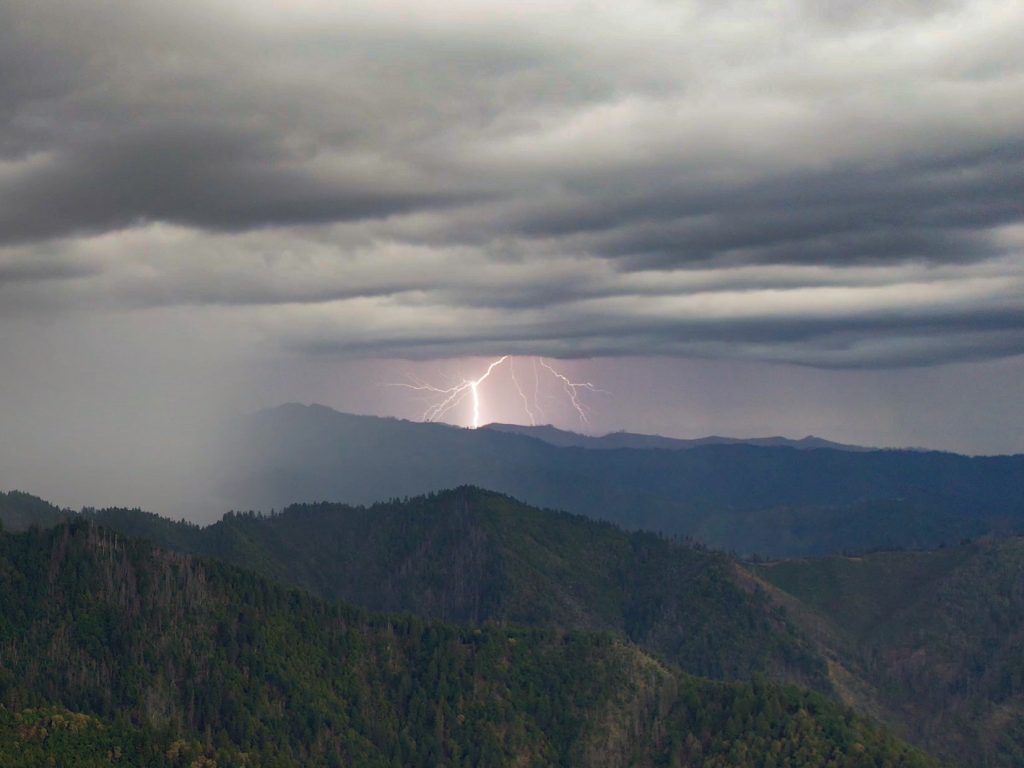
Sediment and Summer Thunderstorms
Thunderstorms and sudden cloudbursts are common in the mountains during the summer. Following a wildfire, they can have dramatic results, especially after a dry year without significant rainfall. A single downpour can set a mountain stream roaring, sending a puff of suspended sediment downstream to wash into the river below. Usually this passes quickly, leaving little trace. Significant rainfall and subsequent runoff normally occur in fall or winter. However, an unexpectedly intense storm directly following a wildfire in 2022 lead to a natural disaster on the Klamath River. In August, heavy rain flooded an area burned by the McKinney fire, California’s largest wildfire that started in July that same summer, resulting in an enormous plume of sludge and debris that killed thousands of fish.1
Sediment is usually mobilized by the large storm systems that come in fall and winter during the rainy season, but a burned landscape is much more vulnerable. Wildfires cause loss of canopy vegetation as well as changes to soil properties. Storms can result in more water flowing over the land, leading to flooding and erosion, while delivering sediment, ash, pollutants, and debris to surface water.2 All that mobilized debris can choke small creeks and block local drainages, turning rivers into muddy, churning maelstroms. And even after the water clears, the excess fine sediment can fill in pore spaces between cobbles where fish lay their eggs (redds), suffocating eggs and aquatic larvae on the bottom; it can also clog and abrade the gills of mature fish.3
While erosion is a natural process, its effects on rivers and streams are highly variable, and the increasing frequency and intensity of wildfires is changing that dynamic. Ongoing research by agencies like the U.S. Geological Survey is shedding new light on wildfire’s impact on soil and water.
Soil properties can change dramatically due to fire. For example, metals can be volatilized and rained down or deposited by ash, and the structures that burn can introduce all sorts of other materials into the mix. Each watershed reacts uniquely to wildfire. Topography, including slope, affects how much erosion occurs. The type of vegetation (or structures) burned and what was in the soil itself affect what ends up in the surface water. And the mechanics of the fire, like how hot the fire burned and how much of the watershed burned, affect what is in the runoff.4
When rains hit, the tremendous amounts of ash and sediment that wash into rivers and reservoirs cause physical disruptions. In addition to the large-scale runoff (landslides and debris flows), smaller-scale runoff increases the amount of fine sediment suspended in water. Sedimentation also decreases the water quality itself by changing the amount and type of dissolved organic matter (DOM). Fire releases nitrogen stored in plants and trees. Geochemists have also found that different trees release different metals, in different concentrations, when burned. For example, when a ponderosa pine burns it releases whatever metals it has absorbed from the soil and air, like iron and manganese. An aspen or spruce might emit more vanadium, lead, magnesium, or copper.5
Salmon redds are most vulnerable during and after spawning season, which starts in October. The first big storm in the Trinity Alps came in October of 2022. Deadwood Creek and Dutch Creek, tributaries to the Trinity River, dumped a ton of sediment into the mainstem that had failed to mobilize in the previous drought years. Deadwood Creek sits high up in the managed river system where some of the heaviest spawning takes place. At the time of the storm, the Trinity River itself was still at baseflow (300 cubic feet per second), so it did not have the momentum to carry the sediment very far and it settled closer to the mouth of the creek, smothering a number of redds.
The solution? Once the eggs have hatched out in the spring, most fish can usually swim away from pulse-disturbances and pollution as long as their movements are not restricted by barriers like road crossings, dams and culverts. TRRP is helping fund watershed projects that limit the sources of excess sediment and remove barriers to migration to give fish more ability to escape difficult conditions. These include the Supply Creek Berm removal project and the Carr Fire Recovery & Sediment Reduction Project, as well as the planned Oregon Gulch Culvert Replacement and East Branch East Weaver Creek Migration Barrier Removal.6 A proposal to synchronize winter storm events with flows out of the dam would help keep tributary sediment from piling up at creek mouths during storm events. The TRRP is also looking to support more projects that emphasize fire resiliency. Restoring the river and its watershed is the ongoing mission of the TRRP.
- 1 Thousands of Fish Found Dead in the Klamath River | Field & Stream (fieldandstream.com)
- 2 Water Quality After Wildfire | U.S. Geological Survey (usgs.gov)
- 3 Wildfire and Its Effects on Streams and Rivers – Surviving Wildfire (extension.org)
- 4,5 Biggest Risk to Surface Water After a Wildfire? It’s Complicated – Eos
- 6 Trinity River Restoration Program 2022 Annual Report (arcgis.com)
